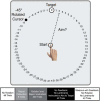Explicit and implicit contributions to learning in a sensorimotor adaptation task
- PMID: 24553942
- PMCID: PMC3931506
- DOI: 10.1523/JNEUROSCI.3619-13.2014
Explicit and implicit contributions to learning in a sensorimotor adaptation task
Abstract
Visuomotor adaptation has been thought to be an implicit process that results when a sensory-prediction error signal is used to update a forward model. A striking feature of human competence is the ability to receive verbal instructions and employ strategies to solve tasks; such explicit processes could be used during visuomotor adaptation. Here, we used a novel task design that allowed us to obtain continuous verbal reports of aiming direction while participants learned a visuomotor rotation. We had two main hypotheses: the contribution of explicit learning would be modulated by instruction and the contribution of implicit learning would be modulated by the form of error feedback. By directly assaying aiming direction, we could identify the time course of the explicit component and, via subtraction, isolate the implicit component of learning. There were marked differences in the time courses of explicit and implicit contributions to learning. Explicit learning, driven by target error, was achieved by initially large then smaller explorations of aiming direction biased toward the correct solution. In contrast, implicit learning, driven by a sensory-prediction error, was slow and monotonic. Continuous error feedback reduced the amplitude of explicit learning and increased the contribution of implicit learning. The presence of instruction slightly increased the rate of initial learning and only had a subtle effect on implicit learning. We conclude that visuomotor adaptation, even in the absence of instruction, results from the interplay between explicit learning driven by target error and implicit learning of a forward model driven by prediction error.
Keywords: cerebellum; explicit; implicit; motor adaptation; motor learning; strategy.
Figures




References
-
- Corkin S. Acquisition of motor skill after bilateral medial temporal-lobe excision. Neuropsychologia. 1968;6:255–265. doi: 10.1016/0028-3932(68)90024-9. - DOI
Publication types
MeSH terms
Grants and funding
LinkOut - more resources
Full Text Sources
Other Literature Sources
Medical
